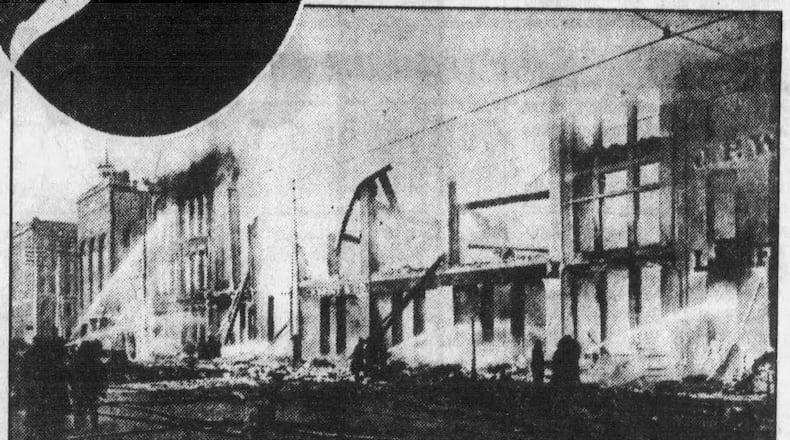Eventually, the entire block was entirely destroyed.
Here are some things to know about the fire:
The buildings
Four six-story buildings belonging to J.P. Wolf & Son were gutted from top to bottom. A three-story building also belonging to the Wolfs and a three-story building of the Dayton Paper Novelty Co. were also destroyed.
After that came the three-story Ezra Bimm & Sons wholesale and retail grocery, then a two-story building housing a saloon, restaurant and tobacco company.
Last came the five-story John Klee building housing the Harter Medicine Co.
A railway station behind the buildings received minor damage
Battling the blaze
Fire Chief Daniel C. Larkin sent in three alarms, which called out all the departments in the city, hose wagons, chemical and steam engines, hook and ladder wagons, and the entire city force of firemen.
The departments of Columbus, Cincinnati, Springfield and other smaller towns were all called for assistance. Xenia and Springfield responded in time to be of assistance, bringing firefighters and equipment by train.
Flames shot high in the air from the roof and were noticeable in all sections of the city.
About 1,700,000 gallons of water were used to fight the fire, according to Dayton Daily News accounts. At one point, there were 25 streams of water aimed at the fire, but they had little effect.
Several members of the Fire Department were badly injured and painfully frostbitten.
The fire ate it’s way through fire walls and iron roofs. As the walls fell, the crowd, estimated at 10,000, cheered wildly at the sight.
The origin of the fire
The fire originated in the boiler room of a three-story building occupied by Wolf & Son, but the exact cause is not known.
A security officer, T.J. Snediker, discovered the fire. He became overcome with smoke, fell down a flight of stairs and was pulled to safety by three bystanders.
Two theories existed at the time. One story is that a boiler-room worker (called a fireman) permitted the fire to run low, and then threw in a quantity of slack coal from which gas accumulated and caused an explosion.
The other is that the worker fired up the boiler and then went to sleep (which was permitted after his shift ended at midnight) and the fire went out of control.
Injuries
No fatalities were reported.
Several firemen, volunteers and citizens were badly injured and sent to local hospitals. The majority of them suffered from frostbite or being overcome with smoke.
George Coy was the most seriously injured fireman after he was hit by a falling wall of flaming bricks. He was knocked unconscious and suffered a broken collar bone and dislocated shoulder.
Insurance claims on the damages
The loss was estimated at the time to be $600,000.
That is equivalent to about $21,199,785 today, according to an online inflation calculator.
Time to modernize the fire department
Dayton was getting bigger, its buildings were taller and the fire department was no longer adequate to protect it.
The next evening, the fire commission presented a list of needs to the city council. It included five steam fire engines, a chemical engine, two new fire houses, salaries for 15 more firefighters, 10 horses and more hose. The total cost was $78,000.
By 1905, The Fire Department had it’s first motorized fire truck which could race through town at 25 miles an hour to reach its destinations.
About the Author





